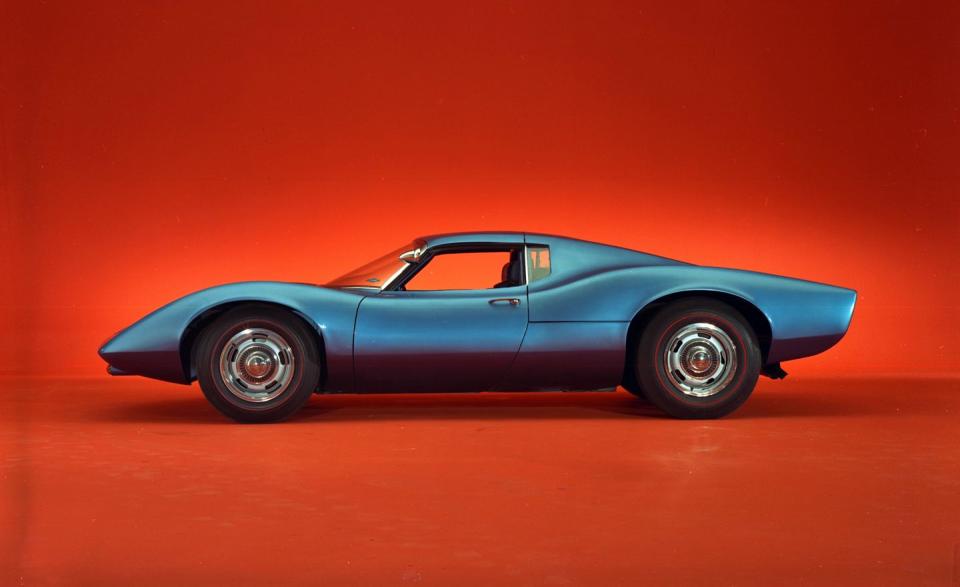The Idea of the Mid-Engined Corvette Began with This 1960s Concept
The first ever mid-engined Corvette will finally become reality with the debut of the C8 in just a few short months. The idea of a mid-engined Corvette, however, stretches back decades. It began with Zora Arkus-Duntov, the father of the Corvette.
As far back as the 1960s, Arkus-Duntov was totally convinced that mid-engine was the only way to go for Corvette to compete effectively in styling, image, and performance against the top European sports cars. As lead Corvette engineer (not yet officially chief engineer) in the 1960s and early 1970s, he had his team design and build several mid-engined prototypes. And he relentlessly lobbied Chevrolet and GM management for approval to bring a mid-engined Corvette to production.
Duntov’s team built the open-wheel, two-seat 1960 mid-engined Chevrolet Engineering Research Vehicle (CERV) and, four years later, the CERV II prototype sports-racer, both efforts focused on motorsports. He first proposed a mid-engined production Corvette in 1964 for 1967. Meanwhile, Frank Winchell’s Chevrolet R&D group built a GS (Grand Sport) II sports racer, then an improved GS-IIb racing chassis. Used primarily to test mid-engine frame and suspension components, it later evolved into the GS-III and, eventually, the 1966 Jim Hall Chaparral race car.

The idea was first explored publicly with the Astro II mid-engined concept car, originally dubbed the XP-880 (for Experimental Prototype), which made its public debut in April 1968 at the New York auto show. The Astro II initiated a blizzard of speculation as to whether it was the next Corvette. Designed to showcase a mid-mounted powertrain but less extreme than the rear-engined Astro I of a year earlier, it was an aerodynamic study to see how slippery a Corvette could be. Unlike the 1967 Corvair-based, rear-engined Astro I, it had real doors to access the passenger compartment, a front storage compartment, and a rear hatch that could be lifted for access to the engine.
Under its swoopy body, the Astro II used mostly off-the-shelf parts. A 400-hp 427-cubic-inch big-block V-8 was mounted backward, with its starter and ring gear under the seatbacks and the tall accessory drive in back. Its original transaxle was a 1963 Pontiac Tempest two-speed automatic, but when that proved too weak, the system was redesigned. Rolling on spoked cast-aluminum wheels with G70-by-15 tires, it boasted four-wheel-disc brakes and could generate an incredible 1.00 g of cornering grip. GM said it almost made it to the showroom.
But Chevrolet was selling every Corvette it could build at the time, so why risk radically changing what was working so well? Would investing substantial sums to go mid-engined increase Corvette sales and profits? Probably not, Chevrolet reasoned, especially since its price would have to be higher and its resulting sales volume much lower. So, while showing mid-engined concept Corvettes excited the press and public and created interest and ink, the idea of actually investing in converting the Corvette to a mid-engine layout was strongly resisted as a major risk.
Still, looking very exotic for its time, with a tilt-back rear and a tilt-forward front section, the Astro II’s styling screamed “Corvette,” and two of its design features were later applied to production Corvettes. For ’73, when new federal bumper requirements kicked in and most American cars got big chrome front bumpers, the Corvette instead received a much more attractive, body-color Astro treatment. Then for ’74, the Corvette’s tail was restyled to look like the Astro II’s.
But that’s as close as the Astro II ever got to the inside of a showroom. It has taken another 50 years for Arkus-Duntov’s dream of a mid-engined Corvette to finally become reality.
('You Might Also Like',)

 Yahoo Autos
Yahoo Autos 